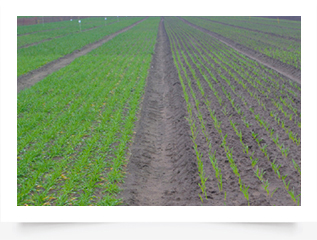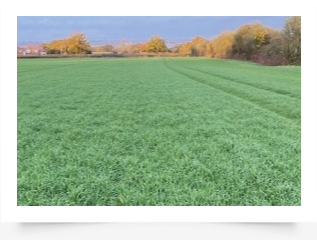Regional planning to get crops on track24 January 2024
After the wet autumn brought havoc to winter crops in many regions, how does agronomy need adapting? ProCam agronomists around the country offer guidance.
With only 25% of winter wheat and barley drilled in North West England, and some crops borderline whether they are worth keeping, some critical field-by-field decisions will be needed in early 2024, says agronomist, Tom Smith.
“Many people are hopeful of drilling more winter wheat up until the end of February [variety dependent], which can pay better than a spring crop here in my opinion. But don’t force later-planted wheat in. Get the seedbed right. And don’t rush in too soon with pre-em herbicides,” he adds.
North West England
Getting early phosphate and nitrogen (N) on once allowable will be important for tillering of backward winter cereals, Tom Smith continues, but not too much while leaching risks remain high.
“Maybe 50-60 kg N/ha for the first application, followed by a normal programme. The key is understanding when the crop is waking up from winter, which is down to soil temperature.
“A phosphite or seaweed based biostimulant for rooting and tiller manipulation is also worth considering. Not many people have applied herbicides – so assess weed situations, such as brome and ryegrass, and apply once temperatures are appropriate.”
A phosphite or seaweed based biostimulant to aid rooting
and tiller manipulation could be a wise decision on backward
cereals, believes Lancashire’s Tom Smith.
East Anglia
With most winter oilseed rape (WOSR) and winter barley planted, but only 60% of the winter wheat area in, remedial action is needed, says Eastern counties agronomist, Drummond Scrase.
“Most WOSR established well, particularly hybrids, and propyzamide and fungicide applications are now planned.
“For cereals, although drilling opportunities were more forthcoming where deeper cultivations were used, shallow cultivations left wetter conditions and poorer establishment, and delayed wheat planting has resulted in slow growth.
“Winter cereals that are established will be candidates for BYDV treatment once crops reach 170 day degrees, partnered with manganese and a top-up herbicide field-by-field. Crops that haven’t received herbicide are a priority for a contact/residual mix before weeds get too large.
“Sulphur (S) requirements will also need addressing – either in spring or with winter applications of Brimstone – because much will have been leached. And early N will be essential on less-developed crops to encourage tillers, followed with a low dose PGR to promote rooting and tillering.”
While some East Anglian growers will continue drilling winter
wheat if conditions allow, others have already decided to
revert to spring wheat or spring barley, says Drummond Scrase.
East Midlands & Yorkshire
With only 20% of winter cereals drilled and only 50% of WOSR surviving, Jim Nutting, who operates in Nottinghamshire, Lincolnshire, and South Yorkshire, predicts a surge in spring cropping, unless a very kind January allows more winter wheat planting.
“Soils are saturated. Since 21 September, 226mm of rain fell in just six weeks.”
To boost flagging winter cereals, Jim advocates nitrogen in February, if possible, although only 40 kg/ha because of leaching risk. With roots likely to be poorly developed, foliar phosphite will also be on his agenda.
“Roots haven’t had to push down for moisture. A lot of crops also haven’t received herbicides, so grass and broad-leaved weeds will need attention.”
Only about half the region’s WOSR survived cabbage stem flea beetle, adds Jim, and some of that has started rotting in waterlogged fields.
“We will only decide what to do with the crop when, or indeed if, it wakes up in the spring.
“Spring barley already features in many rotations, so most growers have experience of growing this, but there could be quite a bit drilled on strong land, and it must go into good seedbeds. If you drill too early and make a mess, it won’t thrive. That said, we target 7.5 t/ha from spring barley on good land and, with a potential malting premium, margins can be good. The other option on kinder land is maize for AD.”
With winter cereal roots not needing to reach down for
moisture, a foliar phosphite to aid rooting will be a first
port of call for Jim Nutting.
Oxfordshire
Extreme variations in crop growth means fields will need managing on a case-by-case basis, says southern regional technical manager, Paul Gruber. ‘Feeding’ smaller crops to ‘nurse’ early spring growth will be among the priorities, he notes.
“About 20% of the winter wheat was drilled early in good conditions and looks normal; 60% was drilled but hit hard by the weather, with some having not received any herbicide; and 20% remains unplanted.
“Residual N in the soil could be low after the deluges. So applying N suitably early will be key in backward crops – as will tailoring other macronutrients plus micronutrients. With many crops poorly rooted, we’ll also be looking to a suitable biostimulant once Continued from page 1 there’s active growth.”
By comparison, Paul says some early-drilled WOSR is huge, so could be a target for trimming back early N inputs, while backward or thin WOSR will need nutrition adjusted to boost green area index (GAI).
We don’t know how future weather will impact on crop
growth – some crops could bounce back, says Paul Gruber,
so fields will need managing on a case-by-case basis.
South East England
Despite plenty of rain, South East England has been relatively lucky, believes regional technical manager, Justin Smith, and in many fields it’s a case of protecting crop potential.
“WOSR looks promising, and we’ll be monitoring GAI and planning initial N fertiliser accordingly. Early sulphur (S) will also play an important role. S helps not only mobilise and utilise N more efficiently but is also beneficial in the plant’s chlorophyll production. Micronutrients such as boron, molybdenum and magnesium are also likely to be included with an early stem extension fungicide for disease control and canopy management.”
Most winter wheat and barley has received a pre-em herbicide, says Justin, and at least one aphicide, as conditions and early drillings continue to favour rapid multiplication.
“First N and S applications will be on a field-byfield basis. Some thick cereals may need reigning back.
“I’m already finding yellow rust in winter wheat and crown rust in oats. Where it’s a problem, I will be looking at a robust T0 fungicide, likely based on triazole chemistry. I can also foresee lots more need for early PGR to encourage rooting and stem wall thickening. Biostimulants can also play a useful role in stimulating early rooting and in helping maintain tillers and alleviating stress. Recent spring droughts have seen crops on poorer soils losing tillers, especially where they have underdeveloped root systems and backward growth because of earlier waterlogging. In these instances, an early biostimulant can be advantageous.”
With some forward canopies, Justin Smith has already
been finding rust in oats (pictured) and winter wheat.
Western counties
Good progress with planting WOSR and winter barley has contrasted sharply with variable winter wheat progress across Herefordshire, Shropshire and into Wales, says agronomist, Harry James, and many winter cereals did not receive autumn sprays.
“Most of the WOSR that has been planted and has survived cabbage stem flea beetle has had propyzamide and autumn fungicides, together with boron which is important for flowering and acts as an ‘anti-freeze’.
“Winter barley is also generally looking well. But while 90% of winter wheat has been drilled and most looks good, some later crops in wet fields are patchy and decisions will need taking whether parts of fields need replacing.
“A lot of winter cereals also haven’t received BYDV sprays. Hopefully frosts will reduce pressure, but preventative sprays may be relevant. A lot of wheat hasn’t received herbicides, so large weeds in early-drilled crops are likely to need contact materials. Later crops could still be an option for residual herbicides, with slower weed growth.
“For thin wheat, N applications might need bringing forward to boost tillering, starting with a low dose in February, and followed by a dose of PGR in early March to do the same. With potentially less soil N available after the wet autumn, residual N will need assessing before N applications start.”
A dose of PGR in early March to aid tillering may be useful
in thin winter wheat, says Harry James.
Aberdeenshire
With wet autumns familiar in Scotland, most winter crops were drilled in good time, says agronomist, Phil Smith, but deluges have had other effects.
“We had 160-170% of our normal rainfall in October,” says Phil, “so autumn herbicides, such as propyzamide, and light leaf spot sprays weren’t applied in WOSR. They’ll need doing at the first opportunity before 31 January.
“The deluges will have also washed away water-soluble soil nutrients. Any excess N will be gone, P will be locked up, and K will be down. S and boron are also water soluble. Application of water-soluble trace elements to redress the balance will need to be front of mind across winter crops as soon as they wake up in spring.
“Normally in winter barley these are applied with a T0 fungicide and PGR, but they might need applying earlier. The extra growth of forward crops could mean their nutrient reserves are diluted. I’ll be looking to apply 25-30% of the total N dose for the season to winter barley as soon as permitted.
“Most winter wheat was also planted okay and looks fine. It’s generally more resilient than barley, but nutrients still need monitoring after the washout weather.”
With water-soluble soil nutrients likely to have been
washed away, applying boron to WOSR at the earliest
opportunity is a key consideration, says Phil Smith.







